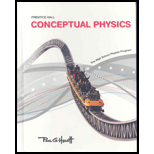
Concept explainers
a. What is the minimum speed for circling Earth in close orbit?
b. What is the maximum speed in an orbit that comes close to Earth at one point?
c. What happens to a satellite traveling faster than the maximum speed described in part (b)?
(a)
The minimum speed for circling Earth in close orbit.
Answer to Problem 14A
Explanation of Solution
Given:
For a satellite to maneuver in low Earth orbit while not falling down, minimum distance required from the Earth’s surface is
Formula used:
Centripetal Force
Gravitational Force
Where,
Calculation:
Force of gravity should balance the Centripetal Force.
Thus,
Simplifying the equation would result in the speed of satellite revolving at low Earth orbit.
Inserting the values of constants, speed of satellite would be
Conclusion:
Thus, minimum speed for a satellite to revolve in close orbit of Earth is 7.78km/s.
(b)
The maximum speed in an orbit that comes close to Earth at one point.
Answer to Problem 14A
Explanation of Solution
Given:
According to Energy conservation principle, total energy of an isolated system remains constant, neither it can be created nor can be destroyed. Total energy is equal to the sum of Potential energy
Calculation:
For an object to come closer to orbit or minimum speed required to escape Earth’s gravity is known as Escape velocity
At this point, total energy of the object initial is equal to the final velocity after escaping the gravity at infinite distance
Thus,
Inserting the values of Gravitational constant, mass of Earth and distance from center of Earth to the object.
Conclusion:
Thus, maximum speed in an orbit that comes close to Earth at one point or escape velocity is
(c)
To explain: The condition to a satellite traveling faster than the maximum speed .
Answer to Problem 14A
It will escape from Earth’s gravity.
Explanation of Solution
Introduction:
Escape velocity is the minimum speed of the satellite which without propulsion can escape Earth’s gravity.
For every celestial body like planet, minimum speed is required to escape from the gravitational field of that celestial body. This speed is said to be as Escape velocity. After reaching this speed, object escape out of gravity and it can travel to infinity without any propulsion or any resistance force because it will keep moving with the achieved speed.
Conclusion:
Thus, once a satellite travels faster than the maximum speed then it will get away from the gravitational field of the planet and can move to any said distance without any work done on the system.
Chapter 14 Solutions
Conceptual Physics: The High School Physics Program
Additional Science Textbook Solutions
University Physics (14th Edition)
The Cosmic Perspective
Cosmic Perspective Fundamentals
Conceptual Physics (12th Edition)
Essential University Physics (3rd Edition)
Physics for Scientists and Engineers: A Strategic Approach, Vol. 1 (Chs 1-21) (4th Edition)
 College PhysicsPhysicsISBN:9781305952300Author:Raymond A. Serway, Chris VuillePublisher:Cengage Learning
College PhysicsPhysicsISBN:9781305952300Author:Raymond A. Serway, Chris VuillePublisher:Cengage Learning University Physics (14th Edition)PhysicsISBN:9780133969290Author:Hugh D. Young, Roger A. FreedmanPublisher:PEARSON
University Physics (14th Edition)PhysicsISBN:9780133969290Author:Hugh D. Young, Roger A. FreedmanPublisher:PEARSON Introduction To Quantum MechanicsPhysicsISBN:9781107189638Author:Griffiths, David J., Schroeter, Darrell F.Publisher:Cambridge University Press
Introduction To Quantum MechanicsPhysicsISBN:9781107189638Author:Griffiths, David J., Schroeter, Darrell F.Publisher:Cambridge University Press Physics for Scientists and EngineersPhysicsISBN:9781337553278Author:Raymond A. Serway, John W. JewettPublisher:Cengage Learning
Physics for Scientists and EngineersPhysicsISBN:9781337553278Author:Raymond A. Serway, John W. JewettPublisher:Cengage Learning Lecture- Tutorials for Introductory AstronomyPhysicsISBN:9780321820464Author:Edward E. Prather, Tim P. Slater, Jeff P. Adams, Gina BrissendenPublisher:Addison-Wesley
Lecture- Tutorials for Introductory AstronomyPhysicsISBN:9780321820464Author:Edward E. Prather, Tim P. Slater, Jeff P. Adams, Gina BrissendenPublisher:Addison-Wesley College Physics: A Strategic Approach (4th Editio...PhysicsISBN:9780134609034Author:Randall D. Knight (Professor Emeritus), Brian Jones, Stuart FieldPublisher:PEARSON
College Physics: A Strategic Approach (4th Editio...PhysicsISBN:9780134609034Author:Randall D. Knight (Professor Emeritus), Brian Jones, Stuart FieldPublisher:PEARSON





